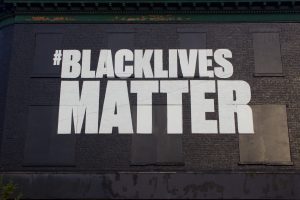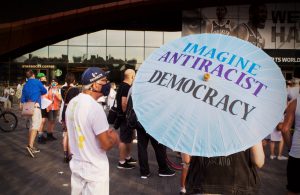
A nation that continues year after year to spend more money on military defense than on programs of social uplift is approaching spiritual death.”
Rev. Dr. Martin Luther King Jr.
The conversation to defund the police and abolish prisons is nothing new. They’ve been happening within criminal justice reform groups for years.
For example, started in September 2018, No New Jails NYC is “a multiracial, intergenerational network fighting against Mayor Bill de Blasio’s inner-borough jails expansion plan.” Their mission statement reads, “Overwhelmingly, New Yorkers agree that all efforts should be dedicated now to closing all jails on Rikers Island, that there is no need to build any more jails, and that the billions of dollars budgeted for new jails should be redirected instead to community-based resources that will support permanent decarceration.”
The goal of such organizations, working alongside the Black Lives Matter Movement, is to radically reimagine what criminal justice looks like in our country. To bring an end to police brutality and the prison-industrial complex by moving away from hyper-policing, punishment, and control and towards restorative justice, rehabilitation, and reentry. Along with the ending of inhumane practices, such as solitary confinement and exploitative prison labor.
In the past months, these discussions have moved beyond college classrooms, guest lectures, and activist groups and been brought to the mainstream. Since early May, New York City has consistently held protests. The trading tag of #defundthepolice and #abolishprisons call to question where our country, states, and cities choose to make and spend their money and what that spending prioritizes.
When our political administration has continuously cut back spending on education, social security, environmental conservation, public health care, but continues to increase its spending on military and police we can begin to question what it says about our priorities as a nation? What does it mean when we are number 1 in incarcerated citizens, and number 17 in literacy (with only 12% of adults reading at a high school graduate to college literacy level)? Why is the idea to defund the police so radical, but defunding education isn’t? Or women’s health care? Or National Park services? Or public art programs? All while knowing that our current system does not lead to a reduction in recidivism or reincarceration, but creates a cycle of poverty and punishment, which disproportionately affects people of color and low-income communities.
By providing sustainable, inclusive, and quality resources our city can shift its values and priorities from controlling to serving the people. Here are 6 ways to reallocate funds to better serve our communities.
The prison has become a black hole in which the detritus of contemporary capitalism is deposited. Mass imprisonment generates profits as it devours social wealth, and thus it tends to reproduce the very conditions that lead people to prison”
Angela Davis
1. Education
Almost all sociologists agree education is the number one path to equal opportunity, wealth, and success. It’s individual access to social mobility. It’s our greatest path to building smarter, active, and viable communities. There’s also a push to ensure our curriculum has intersectional representation to create a deeper, dynamic, and more complete look at history, literature, and social sciences. With fully-funded public education, every child will have equal access to intersectional knowledge, social and emotional learning, extracurricular and cultural programs, and a healthy and safe environment to continuously move us to a better future.
As sociologist and activist writer W.E.B. Du Bois stated, “Education is that whole system of human training within and without the schoolhouse walls, which molds and develops men.”

2. Housing
Finland has essentially ended homelessness. Through the ‘Housing First’ program, those affected by homelessness have received a small apartment and counseling with no preconditions. With an extreme success rate, they have proven that providing permanent housing and the basic groundwork to begin recovering from the causes and effects of homelessness has been more sustainable and cheaper.
It’s hard to give exact numbers on homeless, but in New York City the homeless population accounted for in shelters has steadily increased over the past 5 years. Infrastructure designs, like street spikes, and other forms of policing have received criticism for attacking homeless individuals, and not homelessness. While shelters and other municipalities have continuously worked to support those affected by the city’s now five-decade-long homeless crisis, funding sustainable and permanent affordable housing and income plans are the greatest way to bring an end to homelessness.
3. Addition Rehab
Better funding, support, and awareness for addiction rehab programs will break down systems of poverty and criminalization, and build up community health in NYC. Drug and alcohol addiction is an illness and should be treated as such. By policing and criminalizing addiction, cities are often spending more and perpetuating more harm, such as family breakups and multi-generational poverty. An estimated 50 percent of U.S. prison populations have a drug addiction illness but do not receive the necessary care within prisons.
Programs that prioritize the well-being of patients, research and education, care, rehabilitation, and prevention have proven more effective for individuals and their families affected by addiction. These programs create less costly, long-lasting, and viable results.
4. Health Care
The Covid-19 Crisis has proven we have a flawed public health care system. With New York having the highest number of deaths, over 32,500, we have seen the virus disproportionately affect Black and Latino individuals and posed an increased threat to the senior population. It has created a much-needed call to action on prioritizing funding for public health care and research.
Healthy food and fitness options are disproportionately spread out in neighborhoods, with an estimated 750,000 people living in food deserts or without adequate exercise options, like gyms or parks. Similarly, women and LGBTQ individuals are still underserved when it comes to health care resources. Schools fail to offer an inclusive and complete public and sexual health education. And mental health care is put second or dismissed in conversations about public health. To increase the well-being of its people NYC needs all forms of affordable and accessible health care resources for all communities.

5. Free Public Spaces
Danish architect, Jan Gehl, said: “A good city is like a good party – people stay longer than necessary because they are enjoying themselves.” Public spaces provide us the opportunity to come together and actively engage with our shared community. They should strive to be inclusive and accessible for all ages, backgrounds, and abilities by providing social spaces that fit the communal needs for entertainment, commerce, and recreation.
Public spaces, like community gardens, public meeting halls, outdoor theaters, local markets, and libraries, serve to enrich communities without barriers of entrees such as memberships or other fees. They create self-sustaining micro-communities that people can openly visit as they wish, use in the ways that seem fit, and promote unity for all peoples.
6. Education for Reentry
Again, education serves as our greatest ally to uplift our city.
Prison education and rehabilitation programs have shown the greatest success in ending recidivism, incarceration, and reentry poverty. All at a lower cost than fueling the prison system. For example, Hudson Link programs estimate the cost of $60,000 per year to incarcerate a single person, compared to their $5,000 annual tuition fees. These programs are the final step in ending the school to prison pipeline, the prison industrial complex, and mass incarceration.
As Victor Hugo famously said, “He who opens a school door, closes a prison.”
By funding education, skill-based training, and reentry services incarcerated and formerly incarcerated individuals are better prepared to positively and successfully serve themselves, their families, and their communities.
Additional Resources:
- VOCAL-NY
- Ending the School-to-Prison Pipeline/Building Abolition Futures
- Social Work, Feminism, and Prison Abolition
- Prison Expansion Is Not Prison Reform
- Queering Prison Abolition, Now?
- “What Shall We Do with the Young Prostitute? Reform Her or Neglect Her? ”: Domestication as Reform at the New York State Reformatory for Women at Bedford
- New zine: “What about the rapists?” – Anarchist approaches to crime & justice
- Bedford Hills College Program
- NYC Fiscal Year 2020 Budget
- U.S. Military Spending/Defense Budget 1960-2020
